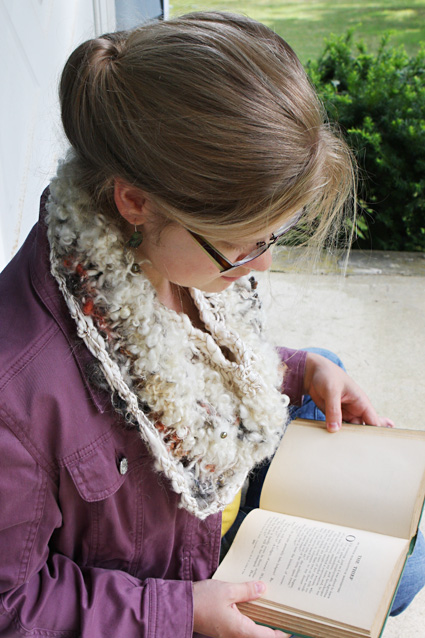

|
|
|

Many spinners love creating textured yarns, but have no idea what to use them for. One of the joys (and frustrations) of knitting with art yarn is that you cannot create a duplicate... ever. Every art yarn is unique, therefore every finished project is unique. Your handspun yarn will look different than mine. So viva la difference! |
||
|
|
Tweet

|
|
|
SIZE |
|
|
FINISHED MEASUREMENTS |
MATERIALS
Recommended needle size
Notions |
|||||
|
GAUGE |
| 6 sts/6 rounds = 4 inches in stockinette stitch |
|
PATTERN NOTES |
|
Since your yarns will be slightly different in thickness and texture than the ones I've spun, be flexible. For example, If you run out of a yarn, use another yarn. Try using four or five smaller skeins of handspun. For a less drapey cowl, cast on 37 stitches. For a finer weight of yarn (chunky, worsted) cast on 24 inches of stitches and knit for 10 inches of length. |
We will be spinning two styles of art yarn for this cowl. Feel free to use smaller skeins of handspun yarn for this cowl, or mixing handspun yarn with commercial yarn. I recommend that all the yarns you use are a chunky or bulky weight. Let the yarn inspire you. HOW TO SPIN the Art Batt Yarn [CC1] For this yarn I used an Art Batt from my shop and a cone of cotton eyelash thread. You can find cones of thread at thrift stores, vintage shops, eBay, and ETSY. You can also use imported novelty threads from your local yarn shop.
Allow the thread to hang from the orifice while you spin the single; it will wrap onto the single.
Continue corespinning and when you want another thread-wrapped section simply drop the thread and allow it to wrap around the yarn while you spin a single. Continue spinning the thread-wrapped lengths of yarn and the corespun lengths of yarn until you have used up the entire art batt. Then end the yarn in a knot and roll it into a ball. HOW TO SPIN: "Curly Pearly" Yarn [CC2] To prepare the first handspun "Curly Pearly" yarn, take the freshwater pearls and string them on the cotton/poly sewing thread. Choose the strongest thread you can find, so that it doesn't snap under pressure. Find a thread you cannot break. We will be using the mohair thread and the cotton/poly thread together to ply the yarn, so the entire weight of the ply isn't on one thread and the yarn will not break when being knit. Fluff the wool locks up with your fingers. This will make them easier to spin. The great thing about spinning this style of yarn is that you don't need any processing equipment (hand cards, wool picker, drum carder, etc.) to create it! Hold a handful of locks in your lap and begin drafting a bulky weight of yarn from the pile. Don't try to control the yarn too much. The longer the staple, the easier it will be to spin this yarn. I have found that a 3+ inch staple is easiest to spin into a curly fuzzy yarn. After the single curly yarn has been spun, take it off the wheel (I rolled mine into a ball because I have one bobbin, if you have multiple bobbins simply ply off the bobbin) and tie the end in a knot with both the thread that has the pearls strung on it and another strong plying thread (I used a commercial mohair thread).
It is important to ply the yarn with two threads at the same time, so that the sewing thread isn't taking all the pull and tension from the wheel. If you only use sewing thread, your ply will snap under pressure and the pearls will run all over the floor. With your left hand, hold the curly wool yarn, with your right hand hold both plying threads, ply the thread and the curly yarn together.
NOTE: I did not set the twist on the yarns I used in this tutorial, but feel free to set your yarns if you prefer not to work with "alive yarns".
|
|
DIRECTIONS Ribbing round: [K3, p2] around. Join CC1. Pick up MC and work with that and CC1 held together. Drop MC and CC1. Using only CC1: Using only CC2: Cut CC2. Bind off loosely. |
|
FINISHING |
| ABOUT THE DESIGNER |
|
Ashley Martineau lives in Boston, Massachusetts, with her husband Brian and wee baby, Sam. |
|
Pattern & images © 2013 Ashley Martineau of Neauveau Fiber Arts. Contact Ashley |